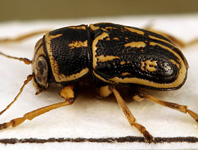Abstract
Pachybrachis holerorum n. sp. is described from the northern Apennines, Italy. The new species is related to P. karamani (Weise, 1893), from which it differs in the shape of the median lobe of the aedeagus and in small differences in chromatic pattern. The close relationship with P. karamani is confirmed by molecular analyses performed on a fragment of 829 nucleotides of the mitochondrial gene Cytochrome c oxidase subunit 1 (cox1). The general mixed Yule-coalescent model, developed for species delimitation using single-locus molecular data, was applied to a cox1 phylogeny in order to test the hypothesis of P. holerorum as a separate species. Information on the host plants, acquired during specimen collection, was confirmed from gut content, targeting a fragment of the plastid large subunit of the ribulose-bisphosphate carboxylase gene and the trnL(UAA) intron. Besides, the lectotype of P. karamani is designated.

